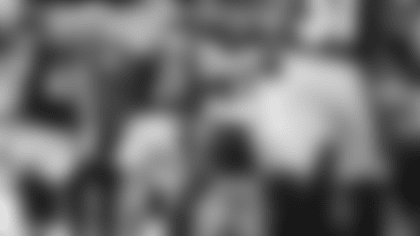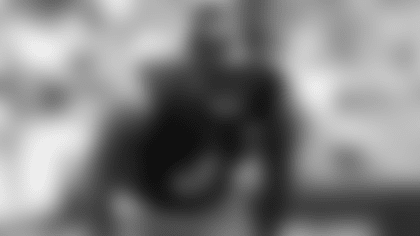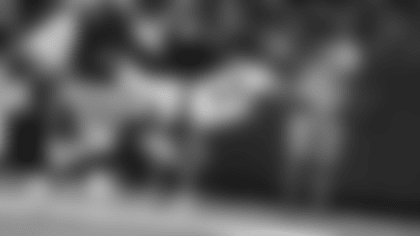Q. You used one of the allotted regular season practices in pads this week. Was that a response to the performance in Cleveland or was it because of the layoff of the mini-bye following a Thursday night game?
A. It was really because of the layoff coming off a mini-bye. It's a way of getting their attention. Oftentimes, attire has an effect on the approach to business. It was a back-to-business day for us, and sometimes you put them in pads to send that messaging.
Q. You have no control over the weather during a game and it is the same for both teams, but during the course of a game played in bad weather are there things that you do or don't do, plays that you call or don't call, because of the conditions?
A. Certainly, and really anticipating conditions, too. We attempted a long field goal, for instance, Thursday night early in the game, because I didn't know what the weather might be like later in the game. You had to take an opportunity to get points, for example. And so not only current weather affects your decision-making, but the potential of future weather may also affect your decision-making.
Q. When talking about bad weather, we usually think of cold or wet or windy. But what about visibility?
A. I really don't get caught up in the whole visibility (issue). It can be an issue at times, but as you mentioned, if it's an issue for one squad, it's an issue for both. From that standpoint, it's a level playing field.
Q. We have talked a lot about what's required to have Joey Porter Jr. shadow a receiver all over the field, in terms of the demands on the other players on defense to make it work. If you wanted to move T.J. Watt around the formation to make it more difficult for offenses to double-team and chip him on his way to the quarterback, what would be required from the other players on defense for that to be successful?
A. It's really very similar to the cornerback travel discussion. If we're moving him around, it requires others to be flexible, but particularly in terms of the (defensive) front that's not a significant endeavor, in terms of guys being able to flop sides and so forth. For instance, Nick Herbig is a swing backup. He happens to be playing right edge right now, but he is left edge capable. And so it's really probably less of an issue for the rush-men than it is for the corners.
Q. One of the intended by-products of a package for Justin Fields is the time it requires opponents to spend preparing for it. But how much time is required for your offense to devise a package and then practice it?
A. You know, this is a component of what we do. Justin has been here all year, and we always want to highlight individual skill-sets. So I don't know that the things we're running present day regarding his package is anything new for us. Most of these concepts we've been working since the spring, and so it is not a significant endeavor for us. It's just simply getting them into the game and identifying a package of plays relative to the opponent that we want to execute.
Q. What is replay assist, and how is it utilized?
A. It's a tool used by officiating to be more accurate, to help administer the game, and to do it without disrupting the game are the major components of it. And so it helps with things like the spotting of the football and things of that nature. Clear and obvious things. And they communicate with headsets to the officiating crew, and sometimes the viewer doesn't even know what's transpired.
Q. What about the coaches? Do they keep you guys in the loop when it's happening?
A. No question, and I'm really sensitive to it, because I'm on the Competition Committee. They do a pretty good job of communicating. Oftentimes it's a little bit tricky because you might have started the process of your decision-making prior to you getting the clarification. So we've got to be light on our feet sometimes, because the fluidity of the communication gets challenged just depending on how long it takes them to identify an issue and correct it.
Q. You mentioned spotting the ball would be something replay assist is used for. What other kind of things?
A. Clear and obvious things. Catch or no catch. Erroneous penalties and things of that nature might assist the officiating crew in terms of picking up a flag.
Q. But penalties are not subject to replay.
A. They cannot add a penalty. They can help take an egregious or erroneous penalty off the ground.
Q. How are defensive players coached to deal with stiff-arms when it comes to tackling running backs or receivers?
A. We work it pretty routinely. You've got to knock (the stiff-arm) down and pull it to you. We play some guys who are known for that, a guy like Derek Henry, and so we put an increased emphasis on it in weeks like that. But it's part of our normal routine in terms of tackling technique. And most positional groups do it at least once a week, at some point during Wednesday, Thursday or Friday's practice.
Q. You mentioned Derek Henry. Are there any other players who are especially effective when it comes to utilizing stiff-arms?
A. Derrick Henry is the standard bearer right now in today's game in terms of (stiff-arms). But with a lot of the bigger ones it is weapon No. 1 in terms of warding off would-be tacklers.
Q. What is meant by the term "max protection?"
A. Usually it means having between seven and eight offensive guys protect the quarterback in a one-dimensional passing circumstance. It's all about the numbers. It's usually seven or eight that we classify as max protection.
Q. It's not about just having one more than what the defense is bringing?
A. It's a loose term to describe seven or eight man protection.
Q. When it comes to Bengals QB Joe Burrow, what would you cite as his difference-making characteristic?
A. His ability to extend and create plays without negativity is probably a calling card of his, and the same with Pat Mahomes. I think it's what separates them from a lot of people. Oftentimes, when a play gets extended, the potential for big plays goes up on both sides – big plays for the offense and big plays for the defense. Those two players in particular, they have a knack for extending plays without the negativity oftentimes that comes with it from an offensive perspective. They make good judgments, they protect the ball, they see the field, they don't throw the ball to the opposing teams under those circumstances. I would view that as a calling card, the ability to extend plays and make plays without the potential of negativity.
Q. How is Burrow's ability to extend plays different from Lamar Jackson's?
A. I don't know that it is dramatically different. I know when Lamar was younger, he was more of a definitive runner once he went downhill into the pocket. But in recent years, Lamar still sees the entire field and is a capable thrower as he extends. And so, they're both challenging. Particularly when you rush them with four to contain them, to get them on the ground, to prevent them from extending plays and seeing the full field and heavier zones, if you're in zone, break down and dissolve becomes a challenge.
Q. During your news conference, you talked about the need for having "enough defense" for Joe Burrow. What does that mean?
A. You can't run out of schematics. I learned that lesson in a real clear way years ago when we were playing Detroit up in Detroit against Matt Stafford, and we had a relatively tight menu. When you play a quarterback who's been a part of a system that they're really comfortable in, that they know inside and out, then they can focus their energies on what it is you're doing. And when you get later in the game, you don't want to run out of schematics, meaning you don't want them to get comfortable with what they're looking at. That's when you see the veteran quarterback come storming back late in games. And you think about the games that the Bengals have been in, sometimes they don't start with great fluidity, but they're always storming back at the opposing defense late in the game. They're producing points in the fourth quarter, they're moving the ball, and it's because regardless of what's transpired, Joe is getting really comfortable with what it is that he's seeing. And so for us, we've got to just carry enough defense. Our menu is probably a little bit bigger than it normally is in the effort to ward off that component of his attack.
Q. What's more effective – a big menu in terms of how you come after him, or a big menu in terms of how you cover?
A. I just think you're gonna need all of the above. As I mentioned, you're gonna need man, zone, relatable zones, spot-drop zones, pressures. When you play these continuity quarterbacks, these guys who know what it is they're doing, who have been in their systems and they're elite – (Jared) Goff, Stafford, Burrow, Lamar – you better carry enough defense. Because if not, if you have a real tight menu, they'll come storming back at you late in the game regardless of what has transpired.
Q. Cincinnati has a potent pair of wide receivers in Ja'Marr Chase and Tee Higgins. How would you compare/contrast them in terms of skill-sets and how they're utilized?
A. I'll start first with Tee. Tee is a big, backside matchup guy. He runs "big boy routes" as we say in the business – slants and so forth. He is a combat catcher. He's a tough tackle. And Chase has it all. He's probably the premier guy at the position in the game right now. There's no route that he can't run. They move him around a lot in an effort to feature him and to get him in favorable matchups and get him away from schematics. And so Tee is more of a stationary guy, you kind of know where he is, you understand his style of play and the type of ball he plays week in and week out. With Chase, you've got to lace up your bootstraps. You never know what you're going to get.
Q. The Bengals defense has 19 sacks, and defensive end Trey Hendrickson has 11.5 of those. How does he defeat what must be constant double-teams?
A. Like all the other elites. I think that's just a component of being an elite rush-man. You're going to see schematics to minimize you, but those who are elite, they still find a way to get the job done. And you definitively can put him into that category with guys who see schematics week in and week out but routinely defeat it. It's really no different than the work that T.J. does week in and week out, or Myles Garrett, or any of the other guys you could describe as a leader in our business. It is routine for them to see and beat double-teams.
Q. After Hendrickson, who is the Bengals main guy on defense?
A. Logan Wilson is a homegrown guy. They drafted him in the third round in 2020, and he plays in all circumstances and situations. He's got a new wrinkle this year – on third-and-5-plus he's a component of the rush, oftentimes as the fourth or fifth rusher. They get in dime-32, and he becomes a component of the rush. He's a really good and versatile player, and he has done a nice job evolving over his time in Cincinnati. So I would definitively describe him as a key and central figure in what they do on defense.













